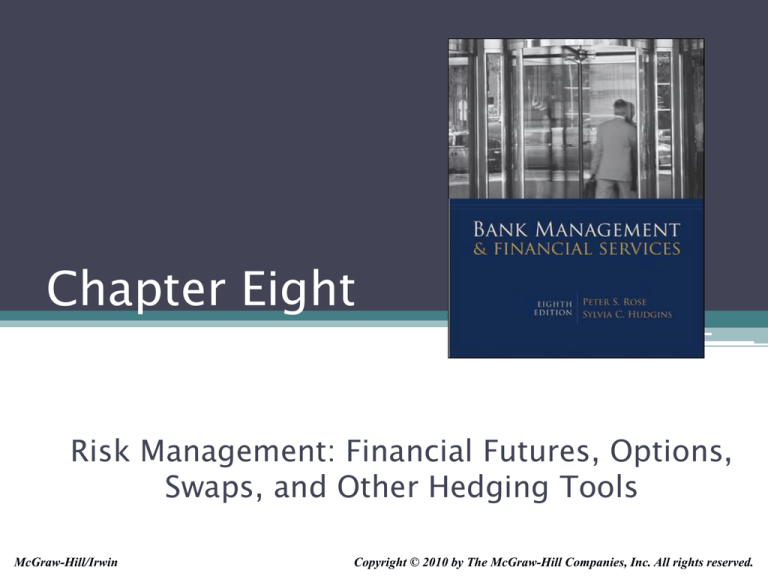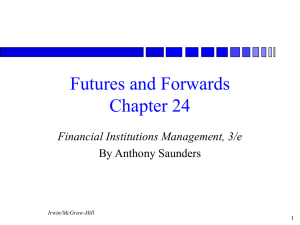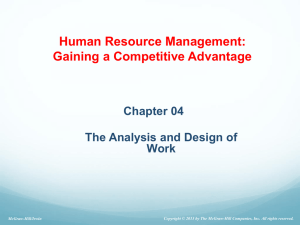
Chapter Eight
Risk Management: Financial Futures, Options,
Swaps, and Other Hedging Tools
McGraw-Hill/Irwin
Copyright © 2010 by The McGraw-Hill Companies, Inc. All rights reserved.
8-2
Key Topics
• The Use of Derivatives
• Financial Futures Contracts: Purpose and
Mechanics
• Short and Long Hedges
• Interest-Rate Options: Types of Contracts
and Mechanics
• Interest-Rate Swaps
• Regulations and Accounting Rules
• Caps, Floors, and Collars
McGraw-Hill/Irwin
Bank Management and Financial Services, 7/e
© 2008 The McGraw-Hill Companies, Inc., All Rights Reserved.
8-3
Derivatives
A Derivative is Any Instrument or
Contract that Derives its Value From
Another Underlying Asset, Instrument,
or Contract, Such as Treasury Bills and
Bonds and Eurodollar Deposits
McGraw-Hill/Irwin
Bank Management and Financial Services, 7/e
© 2008 The McGraw-Hill Companies, Inc., All Rights Reserved.
8-4
Managing Interest Rate Risk
• Derivatives Used to Manage Interest Rate
Risk
▫ Financial Futures Contracts
▫ Forward Rate Agreements
▫ Interest Rate Swaps
▫ Options on Interest Rates
Interest Rate Caps
Interest Rate Floors
Interest Rate Collars
McGraw-Hill/Irwin
Bank Management and Financial Services, 7/e
© 2008 The McGraw-Hill Companies, Inc., All Rights Reserved.
8-5
Financial Futures Contract
• An Agreement Between a Buyer and a Seller
Which Calls for the Delivery of a Particular
Financial Asset at a Set Price at Some Future
Date
• Futures Markets
▫ The Organized Exchanges Where Futures
Contracts are traded
• Interest Rate Futures
▫ Where the Underlying Asset is an InterestBearing Security
McGraw-Hill/Irwin
Bank Management and Financial Services, 7/e
© 2008 The McGraw-Hill Companies, Inc., All Rights Reserved.
8-6
Financial Futures Contracts
IS Gap = IS Assets – IS Liabilities
and
D DA
TL
- DL *
TA
Recall what happens when interest rates rise? Fall?
One of the most popular methods for neutralizing these gap
risks is to buy and sell financial futures contracts
McGraw-Hill/Irwin
Bank Management and Financial Services, 7/e
© 2008 The McGraw-Hill Companies, Inc., All Rights Reserved.
8-7
Background on Financial Futures
• Buyers
▫ A buyer of a futures contract is said to be
long futures
▫ Agrees to pay the underlying futures price
or take delivery of the underlying asset
▫ Buyers gain when futures prices rise and
lose when futures prices fall
McGraw-Hill/Irwin
Bank Management and Financial Services, 7/e
© 2008 The McGraw-Hill Companies, Inc., All Rights Reserved.
8-8
Background on Financial Futures
• Sellers
▫ A seller of a futures contract is said to be
short futures
▫ Agrees to receive the underlying futures
price or to deliver the underlying asset
▫ Sellers gain when futures prices fall and
lose when futures prices rise
McGraw-Hill/Irwin
Bank Management and Financial Services, 7/e
© 2008 The McGraw-Hill Companies, Inc., All Rights Reserved.
8-9
The Purpose of Financial Futures
To Shift the Risk of Interest Rate
Fluctuations from Risk-Averse
Investors to Speculators
McGraw-Hill/Irwin
Bank Management and Financial Services, 7/e
© 2008 The McGraw-Hill Companies, Inc., All Rights Reserved.
8-10
The World’s Leading Futures and Option
Exchanges
• Chicago Board of
Trade (CBT)
• Chicago Board
Options Exchange
• Singapore Exchange
LTD. (SGX)
• Chicago Mercantile
Exchange (CME)
McGraw-Hill/Irwin
Bank Management and Financial Services, 7/e
• Euronext.Liffe
(Eurex)
• Sydney Futures
Exchange
• Toronto Futures
Exchange (TFE)
• South African
Futures Exchange
(SAFEX)
© 2008 The McGraw-Hill Companies, Inc., All Rights Reserved.
8-11
Futures vs. Forward Contracts
▫ Futures Contracts
Traded on formal exchanges (CBOT, CME, etc.)
Involve standardized instruments
Positions require a daily marking to market
▫ Forward Contracts
Terms are negotiated between parties
Do not necessarily involve standardized assets
Require no cash exchange until expiration
No marking to market
McGraw-Hill/Irwin
Bank Management and Financial Services, 7/e
© 2008 The McGraw-Hill Companies, Inc., All Rights Reserved.
8-12
Most Common Financial Futures
Contracts
• U.S. Treasury Bond Futures Contracts
• Three-Month Eurodollar Time Deposit
Futures Contract
• 30-Day Federal Funds Futures Contracts
• One Month LIBOR Futures Contracts
McGraw-Hill/Irwin
Bank Management and Financial Services, 7/e
© 2008 The McGraw-Hill Companies, Inc., All Rights Reserved.
8-13
Hedging with Futures Contracts
Avoiding Higher
Borrowing Costs and
Declining Asset Values
Avoiding Lower Than
Expected Yields from
Loans and Securities
McGraw-Hill/Irwin
Bank Management and Financial Services, 7/e
Use a Short Hedge: Sell
Futures Contracts and
then Purchase Similar
Contracts Later
Use a long Hedge: Buy
Futures Contracts and
then Sell Similar
Contracts Later
© 2008 The McGraw-Hill Companies, Inc., All Rights Reserved.
8-14
Short Futures Hedge Process
• Today – Contract is Sold Through an
Exchange
• Sometime in the Future – Contract is
Purchased Through the Same Exchange
• Results – The Two Contracts Are Cancelled
Out by the Futures Clearinghouse
• Gain or Loss is the Difference in the Price
Purchased for (At the End) and Price Sold
For (At the Beginning)
McGraw-Hill/Irwin
Bank Management and Financial Services, 7/e
© 2008 The McGraw-Hill Companies, Inc., All Rights Reserved.
8-15
Long Futures Hedge Process
• Today – Contract is Purchased Through an
Exchange
• Sometime in the Future – Contract is sold
Through the Same Exchange
• Results – The Two Contracts are Cancelled
by the Clearinghouse
• Gain or Loss is the Difference in the Price
Purchase For (At the Beginning) and the
Price Sold For (At the End)
McGraw-Hill/Irwin
Bank Management and Financial Services, 7/e
© 2008 The McGraw-Hill Companies, Inc., All Rights Reserved.
8-16
Basis Risk
The basis is the cash price of an asset minus
the corresponding futures price for the
same asset at a point in time
▫ For financial futures, the basis can be calculated as
the futures rate minus the spot rate
▫ It may be positive or negative, depending on whether
futures rates are above or below spot rates
▫ May swing widely in value far in advance of contract
expiration
Basis=Cash-market price (or interest rate) –
futures market price (or interest rate)
McGraw-Hill/Irwin
Bank Management and Financial Services, 7/e
© 2008 The McGraw-Hill Companies, Inc., All Rights Reserved.
8-17
Realized Return from Combining Cash
and Futures Market Trading
= Return Earned in the Cash Market
+/- Profit or Loss from Futures Trading
- Closing Basis Between Cash and Futures
Market
- Opening Basis Between Cash and Futures
Market
McGraw-Hill/Irwin
Bank Management and Financial Services, 7/e
© 2008 The McGraw-Hill Companies, Inc., All Rights Reserved.
8-18
Change in the Market Value of the
Futures Contract
McGraw-Hill/Irwin
Bank Management and Financial Services, 7/e
© 2008 The McGraw-Hill Companies, Inc., All Rights Reserved.
8-19
Change in the Market Value of the
Futures Contract
i
Ft F0 -D F0 N
(1 i)
McGraw-Hill/Irwin
Bank Management and Financial Services, 7/e
© 2008 The McGraw-Hill Companies, Inc., All Rights Reserved.
8-20
Number of Futures Contracts
Needed
TL
(DA - D L *
)*T A
TA
D F * P riceof t heFut ures Cont ract
McGraw-Hill/Irwin
Bank Management and Financial Services, 7/e
© 2008 The McGraw-Hill Companies, Inc., All Rights Reserved.
8-21
Quick Quiz
• What are financial futures contracts? Which
financial institutions use futures and other
derivatives for risk management?
• How can financial futures help financial
service firms deal with interest rate risk?
• What futures transactions would most likely
be used in a period of rising interest rates?
Falling interest rates?
McGraw-Hill/Irwin
Bank Management and Financial Services, 7/e
© 2008 The McGraw-Hill Companies, Inc., All Rights Reserved.
8-22
Interest Rate Option
It Grants the Holder of the Option the
Right but Not the Obligation to Buy or
Sell Specific Financial Instruments at
an Agreed Upon Price.
McGraw-Hill/Irwin
Bank Management and Financial Services, 7/e
© 2008 The McGraw-Hill Companies, Inc., All Rights Reserved.
8-23
Types of Options
• Put Option
▫ Gives the Holder of the Option the
Right to Sell the Financial Instrument
at a Set Price
• Call Option
▫ Gives the Holder of the Option the
Right to Purchase the Financial
Instrument at a Set Price
McGraw-Hill/Irwin
Bank Management and Financial Services, 7/e
© 2008 The McGraw-Hill Companies, Inc., All Rights Reserved.
8-24
Most Common Option Contracts
Used By Banks
• U.S. Treasury Bond Futures Options
• Eurodollar Futures Option
McGraw-Hill/Irwin
Bank Management and Financial Services, 7/e
© 2008 The McGraw-Hill Companies, Inc., All Rights Reserved.
8-25
Principal Uses of Option Contracts
• 1. Protecting a security portfolio through the use of put
options to insulate against falling security prices (rising
interest rates); however, there is no delivery obligation
under an option contract so the user can benefit from
keeping his or her securities if interest rates fall and
security prices rise
• 2. Hedging against positive or negative gaps between
interest-sensitive assets and interest- sensitive
liabilities; for example, put options can be used to
offset losses from a negative gap when interest rates
rise, while call options can be used to offset a positive
gap when interest rates fall.
McGraw-Hill/Irwin
Bank Management and Financial Services, 7/e
© 2008 The McGraw-Hill Companies, Inc., All Rights Reserved.
8-26
McGraw-Hill/Irwin
Bank Management and Financial Services, 7/e
© 2008 The McGraw-Hill Companies, Inc., All Rights Reserved.
8-27
McGraw-Hill/Irwin
Bank Management and Financial Services, 7/e
© 2008 The McGraw-Hill Companies, Inc., All Rights Reserved.
8-28
Speculation vs. Hedging
• With financial futures, risk often cannot be
eliminated, only reduced.
▫ Traders normally assume basis risk in that
the basis might change adversely between
the time the hedge is initiated and closed
• Perfect Hedge
▫ The gains (losses) from the futures position
perfectly offset the losses (gains) on the spot
position at each price
McGraw-Hill/Irwin
Bank Management and Financial Services, 7/e
© 2008 The McGraw-Hill Companies, Inc., All Rights Reserved.
8-29
Federal Funds Options and Futures
• Represents the Consensus Opinion Of the
Likely Future Course of Market Interest
Rates
• Public Trading for Futures Contract Began
at the CBOT in 1988
• Public Trading on Options Contracts Began
in 2003
McGraw-Hill/Irwin
Bank Management and Financial Services, 7/e
© 2008 The McGraw-Hill Companies, Inc., All Rights Reserved.
8-30
Regulations For Options and Future
Contracts
• OCC – Risk Management of Financial
Derivatives: Comptrollers Handbook
• FASB – Statement 133 – Accounting for
Derivatives Instruments and Hedging
Activities
McGraw-Hill/Irwin
Bank Management and Financial Services, 7/e
© 2008 The McGraw-Hill Companies, Inc., All Rights Reserved.
8-31
Interest Rate Swap
A Contract Between Two Parties to
Exchange Interest Payments in an
Effort to Save Money and Hedge
Against Interest-Rate Risk
McGraw-Hill/Irwin
Bank Management and Financial Services, 7/e
© 2008 The McGraw-Hill Companies, Inc., All Rights Reserved.
8-32
Interest –Rate Swap
McGraw-Hill/Irwin
Bank Management and Financial Services, 7/e
© 2008 The McGraw-Hill Companies, Inc., All Rights Reserved.
8-33
Quality Swap
• Borrower with Lower Credit Rating
Pays Fixed Payments of Borrower with
Higher Credit Rating
• Borrower with Higher Credit Rating
Pays Short-Term Floating Rate
Payments of Borrower with Lower
Credit Rating
McGraw-Hill/Irwin
Bank Management and Financial Services, 7/e
© 2008 The McGraw-Hill Companies, Inc., All Rights Reserved.
8-34
Further…
• Firms with a negative GAP can reduce risk
by making a fixed-rate interest payment in
exchange for a floating-rate interest receipt
• Firms with a positive GAP take the opposite
position, by making floating-interest
payments in exchange for a fixed-rate
receipt
McGraw-Hill/Irwin
Bank Management and Financial Services, 7/e
© 2008 The McGraw-Hill Companies, Inc., All Rights Reserved.
8-35
Risks of Interest Rate Swaps
• Substantial Brokerage Fees
• Credit Risk
▫ The counterparty may default on the exchange of
the interest payments
▫ Only the interest payment exchange is at risk,
not the principal
• Basis Risk
▫ A swap’s reference interest rates are not the
same as those attached to all the assets and
liabilities (LIBOR, bond rates, etc.), so rates do
not change exactly the same -> some risk
remains
• Interest Rate Risk
McGraw-Hill/Irwin
Bank Management and Financial Services, 7/e
© 2008 The McGraw-Hill Companies, Inc., All Rights Reserved.
8-36
Netting
The Swap Parties Only Swap the Net
Difference Between the Interest
Payments. This Reduces the Potential
Damage if One Party Defaults on its
Obligation
McGraw-Hill/Irwin
Bank Management and Financial Services, 7/e
© 2008 The McGraw-Hill Companies, Inc., All Rights Reserved.
8-37
Currency Swap
An Agreement Between Two Parties,
Each Owing Funds to Other
Contractors Denominated in Different
Currencies, to Exchange the Needed
Currencies with Each Other and Honor
Their Respective Contracts.
McGraw-Hill/Irwin
Bank Management and Financial Services, 7/e
© 2008 The McGraw-Hill Companies, Inc., All Rights Reserved.
8-38
Interest Rate Cap
Protects the Holder from Rising
Interest Rates. For an Up Front Fee
Borrowers are Assured Their Loan Rate
Will Not Rise Above the Cap Rate
McGraw-Hill/Irwin
Bank Management and Financial Services, 7/e
© 2008 The McGraw-Hill Companies, Inc., All Rights Reserved.
8-39
Interest Rate Floor
A Contract Setting the Lowest Interest
Rate a Borrower is Allowed to Pay on a
Flexible-Rate Loan
McGraw-Hill/Irwin
Bank Management and Financial Services, 7/e
© 2008 The McGraw-Hill Companies, Inc., All Rights Reserved.
8-40
Interest Rate Collar
A Contract Setting the Maximum and
Minimum Interest Rates That May Be
Assessed on a Flexible-Rate Loan. It
Combines an Interest Rate Cap and
Floor into One Contract.
McGraw-Hill/Irwin
Bank Management and Financial Services, 7/e
© 2008 The McGraw-Hill Companies, Inc., All Rights Reserved.
8-41
Quick Quiz
• Explain what is involved in a put option?
• What is a call option?
• Suppose market interest rates were
expected to rise. What type of option would
normally be used?
• If rates were expected to fall, what type of
option would a financial institution’s
manager be likely to employ?
McGraw-Hill/Irwin
Bank Management and Financial Services, 7/e
© 2008 The McGraw-Hill Companies, Inc., All Rights Reserved.









